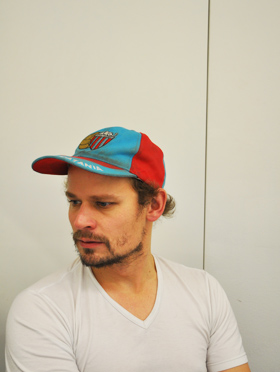Michael Beutler
Grässlin Collection
14.03.–13.05.2012

© Photo: Sunah Choi, 2011
Grässlin Collection
14.03.–13.05.2012

© Photo: Sunah Choi, 2011
|
Intro Views of the exhibition
The artist Michael Beutler (*1976 in Oldenburg) develops installations based on the situation of the respective exhibition: this may either be in the interior space of a given art institution, or within urban landscapes. Each of the voluminous formats of his installations refer to the surrounding architecture, either by entering into a dialog with it or by transforming it. At the ZKM | Museum of Contemporary Art, the artist erected »A-frame« (2007), a triangular sculptural space with walls that are comprised of paper. By way of this intervention, the exhibition space loses its strict character, evolving into a potpourri of kaleidoscopically glimmering colors. The artist's treatment of the visitors is also uncommon: their attitude towards the work of art is not that of a passive spectator; instead they become part of the spatial arrangement. The shape of »A-frame« alludes to an architectural house style of the same name, which experienced a boom in the private sector of the American building industry during the post-war era. The steeply angled roofs extending from the ridge to the foundation line simultaneously function as walls facilitating a cost-effective construction of prefabricated parts. Thanks to the simplicity of the do-it-yourself construction principle, the comfort and affordability of the materials, the A-frame was to become the most favored leisure house among North Americans throughout the 1950s and 1960s. The A-frame, deriving from the ideas of modern architecture, at the same time follows the tradition of Japanese, Polynesian as well as European prototypes. Michael Beutler's art draws its inspiration from the stylistic elements of the artistic avant-garde and from manufacturing processes harking back to preindustrial epochs. The reductive form of the equilateral triangle, the color design, and the application of simple building materials (paper, aluminum, press board, glue, cardboard, cable ties etc.) are reminiscent of the works of geometric abstraction and the “poor” material aesthetics dating from the 1920s and 1960s as well as of Minimal Art: that said, the response to the exhibition situation tends to rather take its cue from such artists as Daniel Buren. Conversely, what remains of central importance to Beutler is both the crafted emergence of his works in collaboration with several committed assistants and friends - the specific influence which likewise flows into the works - in conjunction with its “constructedness”. This approach may well have found support among the advocates of the Arts and Crafts Movement, which rejected the processes of mass manufacturing already from the second half of the nineteenth century onwards. One remaining supporting pillar and two tables in the interior space of the “tent” remind one of the atmosphere of the temporary workshop in which staff members at Beutler's Berlin gallery and friends collaborated in the emergence of »A-frame«. These are the working devices used for the manufacture of the paper honeycomb for »A-frame«. Two people may simultaneously produce the same sized stripes of paper honeycomb at one of the tables. At the second table, differently sized stripes are produced with the aid of a stencil system. In most cases, the archaic-looking mechanical manufacturing devices developed by the artist himself, which are used for folding, pressing, ruffling, rolling, cutting, etc., belong to the work and are hence likewise exhibited. The artist emphasizes the difference between the development process of his works and a performance: »I do not make performances as I am more interested in the product resulting from the working process. At the same time, this product echoes the working atmosphere. It would certainly be different, if an audience followed the proccess. Rather than having somebody watch the production process when working with this flaw or that press, I am interested in what comes into existance when a few people are tinkering together and maybe share stories that happened the previous day.« [1] Curator: Daria Mille [1] Conversation with Michael Beutler, Karlsruhe, ZKM | Center for Art and Media, 06.03.2012. |

